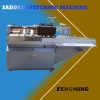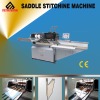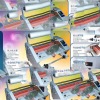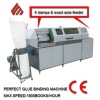SADDLE STITCHING MACHINE 1) CE & ISO 9001:2000 certificated 2) Manual feeding 3) STITCHING MACHINE
The mid-range Most mid-sized printers are not looking for 20,000/hr. plus performance, but a versatile saddlestitching system at the right price. Muller Martini has this market well covered with its Prima and Bravo-T models. However, there are newcomers. Vijuk Equipment has been importing the Purlux Shanghai 321-T saddlestitcher and enjoying great sales success. The 321-T runs at 10,000/hr. with horizontal (flat) pockets that can be quickly switched from 1:1 to 1:2 feed ratio with a simple clutch. Both cards and inserts can be fed from the horizontal pockets without having to rely on special feeders. The machine has missing signature photocells, double-sheet calipers, oblique sheet monitoring and over-under calipers. Books rejected for any reason will automatically dump into a reject bin. The 321-T will support up to 10 pockets. Its cover feeder has multiple air-blast nozzles to separate UV-coated covers, and scoring and folding of the cover can be adjusted as the machine runs. The 321-T's three-knife trimmer can accommodate a fourth and fifth knife center-cut assembly for two-up book production. The trimmer safety hood rises vertically to allow three-sided access. The 321-T also features top-of-the-line Siemens controls and a Mitsubishi PLC. Heidelberg's ST 450 saddlestitcher is a well-designed machine that takes some new tacks in giving printers flexibility without sacrificing throughput, topping out at a respectable 14,000 books per hour. The ST 450 does not use fixed signature feeders (or pockets). Instead, each pocket is its own separate feeding system and can be placed on the gathering chain on either side as needed. The ST 450 has a wide media range, from 3?x 5 up to 12?x18?.Signature separation suckers have their own vacuum source, so that if one fails, feeding and opening will not be compromised. A new stitching head unit permits small- format work to be stapled twice. The stitching heads have also been designed to be very low-wear. One of the stitcher's biggest features is that it is fully JDF ready. Prepress set-up data is accepted by the system, and once product dimensions are accepted, a lot of good things happen quickly. The gathering chain and feeders are automatically synchronized for signature feeding. The stitcher, trimmer infeed, trimmer and compensating stacker also travel to the correct positions automatically. The wire feed length is also automatically adjusted for product thickness. Best Graphics Osako Tener series saddlestitcher has also done well in the mid-range market. The Japanese-built machine incorporates many very useful goodies into a well-priced and performing system. Individual signature scanners (both opto and camera-based) can verify that every signature has dropped onto the chain correctly. The Tener has wire monitor that verifies the absence of a stitch, a central lubrication system, a wireless remote control that can stop and start the machine, a digital caliper (as opposed to a mechanical design), a misfeed control with downstream inhibit. The ORF-836 rotary pocket can be easily tilted to the appropriate angle to allow a better drop for difficult signatures at higher speeds. Each feeder also has its own pump for better air pressure and vacuum. The ORF-836 incorporates high- and low-folio grippers. The Osako OCS-203T Cross Stacker permits the entire system to run at the highest speeds.
SEMI-AUTO SADDLE STITCHING MACHINE












